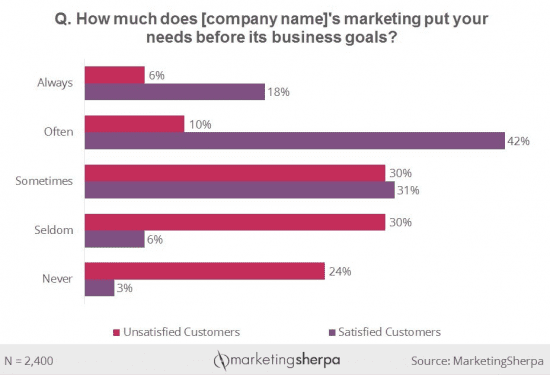How to engage your audience with a customer-focused relationship
It seems to be a trend in the world of digital marketing: Brands are leaning heavily on their product instead of their customers. Coca-Cola recently rebranded its Coke Zero product to Coca-Cola Zero Sugar, abandoning advertisements about the experiences of people drinking its beverages in favor of a product-oriented focus on ingredients and taste.
Coca-Cola believes this product-centered approach will drive sales and create a loyal culture of followers, but this mindset runs counter to human behavior. An overemphasis on the bells and whistles of a product might work in some industries, but people are far more likely — to the tune of a jaw-dropping 269 percent, according to one study — to do business with companies that take their needs into account.
Think about the last time you tried to buy a car. I suspect the salesperson spent hours talking about the features, gadgets, and design aspects of the car. And you probably did not care that the car could zoom from zero to 60 in 2.2 seconds or that the controls for the radio were right next to your hand. You were likely more interested in whether the vehicle met the needs of your family.
Had the salesperson instead asked how you plan to use the vehicle and what you dislike about your current car, it might have been a more pleasant experience. Customers are more interested in learning what a product does for them and less interested in hearing how this car compares to competitors.
The same theory applies to digital marketing. By considering the interests, wants, and needs of customers, brands can emphasize how a given product might solve specific challenges. Marketers must get their customers talking to understand their unique pain points. This insight is tremendously useful when cementing a marketing strategy, and it sets you up to sell by design instead of by chance.
So how do you get started? Here are four tips for implementing a customer-focused process:
1. Stop underestimating data.
Nearly 90 percent of marketers consider data their most underutilized asset. If you can measure it, you can manage it, but you cannot manage things that you fail to measure. Collect as much data as possible, and spend time analyzing it for trends that you can use to generate leads and drive sales. If possible, make these data-centric exchanges conversational and interactive when engaging with customers. Ask your customers what they need.
Your research will help you relate to your customers and shape what I call your W.I.N. list: what’s important now. This list of life goals should include everything that is important right now to make your next significant personal and professional moves. The end goal is definitely critical, but incremental steps along the way are equally as important. Considering the amount of white noise in the marketing world, it is necessary to differentiate your company in some way. The best way to achieve separation for your brand is to truly understand your customers — and data can play a big role to help you achieve your goals.
2. Be flexible, not breakable.
Even the best-laid plans of marketers can go awry. You might hit a roadblock, but that does not mean you should abandon your entire strategy. Instead of pulling the plug, take the time to consider why it failed. Tweak your strategy, believe in your system, and start again.
Consider Amazon, which is arguably the most innovative company of our time. Despite several high-profile failures, Amazon continues to reinvent the wheel. Remember the ill-fated Fire Phone? It certainly resulted in a bit of egg on Amazon’s face, but that did not stop the company from going back to the drawing board to try again. The company learned from those mistakes and eventually incorporated some elements into its new Echo Show.
Most successful endeavors involve some amount of failure. You might fall down seven times, but you need to stand up eight times. Learn from your mistakes and come back with something bigger and better. A marketing strategy that incorporates the same openness and determination is bound to succeed.
3. Get your story straight.
Does your website tell a story? Does it match your social media posts? Does your social content sync with the stories coming from your sales reps? Each platform of your brand influences every other foundation of your business to create a continuum of communication.
Consider Anthropologie, a clothing retailer that truly excels at content marketing. Anthropologie understands the wants and needs of its customers, and its content speaks to those needs by delivering a consistent story across its store, blog, website, and social accounts. It offers contests, photos, and lifestyle tips across these platforms, ensuring customers remain engaged and loyal to the brand — with 2.3 million Instagram followers, its customer loyalty seems secure.
When you tell your story, be as honest as possible. Be authentic. Even though we might be afraid to call our babies — or our businesses, in this case — ugly, it is OK to let customers see the truth behind the curtain. People want something that feels real instead of canned and scripted. Deliver a consistent, authentic story, and consumers will be hooked. This sort of brand alignment helps build trust in your company and enables your team to use storytelling in the sales process.
4. Sleep with one eye open.
A Gartner survey revealed that the number of companies that planned to invest in big data dropped by 6 percent in 2016. If that trend were to continue, industry insights and trends might not be as prolific in the years to come.
I encourage clients to spend 90 percent of their time driving business with a marketing plan. I adhere to the adage of planning your work and working your plan. But what about the remaining 10 percent of your time?
In addition to monitoring what your competitors are doing, dedicate a small team at your company to research and development. Give them a budget, and let them pursue ideas nobody else has tackled. Whether something sounds unimportant or insane, give them space to experiment. You will stay on the cutting edge while nurturing an innovative company culture.
Not buts about it, you must go outside your comfort zone to identify your customers and determine how to appeal to their unique needs. Instead of trying to sell people on the myriad features of your product, talk about what your product does for potential customers. A client-focused process helps you discover the needs and wants of your clients while allowing you to connect with them on a personal level.
Think of it this way: When we talk about our lives, we talk about designing the life we want instead of simply living it. It is easy to say, “I want to make a million dollars and live in a white house with a picket fence,” but those words are hollow without actions to back them up. We can turn our dreams into reality by designing a plan rooted in our wants and needs. By taking a similar tact, digital marketers can cut through the clutter and serve the needs of their clients.




 Thanks to Michael Ray Newman for sharing his advice and opinion in this post. Michael is the CEO of
Thanks to Michael Ray Newman for sharing his advice and opinion in this post. Michael is the CEO of